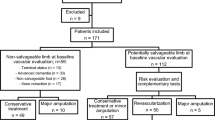Abstract
The aim of the present study was to clarify the characteristics of Japanese critical limb ischemia (CLI) patients and analyze the rates of real-world mortality and amputation-free survival (AFS) in all patients with Fontaine stage IV CLI who were treated with/without revascularization therapy by an intra-hospital multidisciplinary care team. All consecutive patients who presented with CLI at Showa University Fujigaoka Hospital between April 2008 and March 2014 were prospectively registered. The intra-hospital committee consisted of cardiologists, plastic surgeons, dermatologists, diabetologists, nephrologists, cardiovascular surgeons, and vascular technologists. The primary endpoint of this study was all-cause mortality and AFS during the follow-up period. The present study included 145 patients with Fontaine stage IV CLI. The mean age was 76.5 ± 10.2 years. The all-cause mortality rate during the follow-up period (15.5 ± 16.1 months) was 21.4 %. The AFS rate during the follow-up period (14.1 ± 16.4 months) was 58.6 %. A multivariate Cox proportional hazards regression analysis found that age >75 years and hemodialysis were significantly associated with all-cause mortality; and that age >75 years, Rutherford 6, and wound infection were significantly associated with AFS. A multidisciplinary approach and comprehensive care may improve the outcomes and optimize the collaborative treatment of CLI patients. However, all-cause mortality remained high in patients with Fontaine stage IV CLI and early referral to a hospital that can provide specialized treatment for CLI, before the occurrence of major tissue loss or infection, is necessary to avoid primary amputation.



Similar content being viewed by others
References
Norgren L, Hiatt WR, Dormandy JA, Nehler MR, Harris KA, Fowkes FGR, On behalf of the TASC II Working Group (2007) Inter-society consensus for the management of peripheral arterial disease (TASC II). J Vasc Surg 45(1 Suppl):S5–S67
Bhatt DL, Steg PG, Ohman EM, Hirsch AT, Ikeda Y, Mas JL, Goto S, Liau CS, Richard AJ, Rother J, Wilson PWF, For the REACH Registry Investigators (2006) International prevalence, recognition, and treatment of cardiovascular risk factors in outpatients with atherothrombosis. JAMA 295:180–189
Yamazaki T, Goto S, Shigematsu H, Shimada K, Uchiyama S, Nagai R, Yamada N, Matsumoto M, Origasa H, Bhatt DL, Steg PG, Ikeda Y, for the REACH Registry Investigators (2007) Prevalence, awareness and treatment of cardiovascular risk factors in patients at high risk of atherothrombosis in Japan. Circ J 71:995–1003
Kumagai M, Marui A, Tabata Y, Takeda T, Yamamoto M, Yonezawa A, Tanaka S, Yanagi S, Ito-Ihara T, Ikeda T, Murayama T, Teramukai S, Katsura T, Matsubara K, Kawakami K, Yokode M, Shimizu A, Sakata R (2015) Safety and efficacy of sustained release of basic fibroblast growth factor using gelatin hydrogel in patients with critical limb ischemia. Hear Vessels. doi:10.1007/s00380-015-0677-x
Takahara M, Kaneto H, Katakami N, Iida O, Matsuoka M, Shimomura I (2014) Effect of sarpogrelate treatment on the prognosis after endovascular therapy for critical limb ischemia. Heart Vessels 29:563–567
Conte MS, Geraghty PJ, Bradbury AW, Hevelone ND, Lipsitz SR, Moneta GL, Nehler MR, Powell RJ, Sidawy AN (2009) Suggested objective performance goals and clinical trial design for evaluating catheter-based treatment of critical limb ischemia. J Vasc Surg 50:1462–1473
Iida O, Nakamura M, Yamauchi Y, Kawasaki D, Yokoi Y, Yokoi H, Soga Y, Zen K, Hirano K, Suematsu N, Inoue N, Suzuki K, Shintami Y, Miyashita Y, Urasawa K, Kitano I, Yamaoka T, Murakami T, Uesugi M, Tsuchiya T, Shinke T, Oba Y, Ohara N, Hamasaki T, Nanto S (2013) Endovascular treatment for infrainguinal vessels in patients with critical limb ischemia: OLIVE registry, a prospective, multicenter study in Japan with 12-month follow-up. Circ Cardiovasc Interv 6:68–76
Sumpio BE, Armstrong DG, Lavery LA, Andros G, SVS/APMA writing group (2010) The role of interdisciplinary team approach in the management of the diabetic foot: a joint statement from the Society for Vascular Surgery and the American Podiatric Medical Association. J Vasc Surg 51(6):1504–1506
Horie T, Onodera R, Akamatsu M, Ichikawa Y, Hoshino J, Kaneko E, Iwashitah C, Ishidai A, Tsukamotoj T, Teramukai S, Fukushima M, Kawamura A, For Japan Study Group of Peripheral Vascular Regeneration Cell Therapy (JPRCT) (2010) Long-term clinical outcomes for patients with lower limb ischemia implanted with G-CSF-mobilized autologous peripheral blood mononuclear cells. Atherosclerosis 208:461–466
Wolfe JHN, Wyatt MG (1997) Critical and subcritical ischaemia. Eur J Vasc Endovasc Surg 13:578–582
Conrad MF, Crawford RS, Hackney LA, Paruchuri VP, Abularrage CJ, Patel VI, Lamuraglia GM, Cambria RP (2011) Endovascular management of patients with critical limb ischemia. J Vasc Surg 53:1020–1025
Miyahara T, Suhara M, Nemoto Y, Shirasu T, Haga M, Mochizuki Y, Matsukura M, Arai T, Taniguchi R, Nemoto M, Yamamoto S, Nishiyama A, Hosaka A, Hoshina K, Okamoto H, Shigematsu K, Miyata T, Watanabe T (2015) Long-term results of treatment for critical limb ischemia. Ann Vasc Dis 8:192–197
Chung J, Modrall G, Ahn C, Lavery LA, Valentine RJ (2015) Multidisciplinary care improves amputation-free survival in patients with chronic critical limb ischemia. J Vasc Surg 61:162–169
Zayed H, Halawa M, Maillardet L, Sidhu S, Edmonds M, Rashid H (2008) Improving limb salvage rate in diabetic patients with critical leg ischaemia using a multidisciplinary approach. Int J Clin Pract 63:855–858
Acknowledgments
The authors thank Yuki Henmi, Tomoko Sasai, Mamoru Hatakeyama, Mie Hashimoto, and Akira Kaminomiya in the physiological laboratory in Showa University Fujigaoka Hospital for their technological assistance, and DRs. Kenta Miyabe, Seiko Nakae, Yuka Suzuki, Taisuke Kamiyama, Chie Sugisawa in Showa University Fujigaoka Hospital for their help for this study.
Author information
Authors and Affiliations
Corresponding author
Ethics declarations
Conflict of interest
The authors do not have any disclosures regarding financial relationships with a biotechnology manufacturer, a pharmaceutical company, or other commercial entity that has an interest in the subject matter or materials discussed in the manuscript.
Rights and permissions
About this article
Cite this article
Suzuki, H., Maeda, A., Maezawa, H. et al. The efficacy of a multidisciplinary team approach in critical limb ischemia. Heart Vessels 32, 55–60 (2017). https://doi.org/10.1007/s00380-016-0840-z
Received:
Accepted:
Published:
Issue Date:
DOI: https://doi.org/10.1007/s00380-016-0840-z




